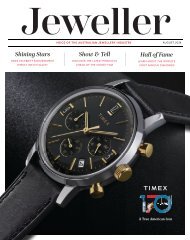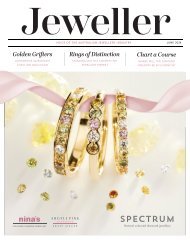Jeweller - May 2021
Create successful ePaper yourself
Turn your PDF publications into a flip-book with our unique Google optimized e-Paper software.
All Things Bright and Beautiful | COLOURED GEMSTONE FEATURE<br />
L to R: Van Cleef & Arpels brooch; Bulgari necklace Sicis ring L to R: <strong>Jeweller</strong>y Theatre brooch; Chopard necklace; Frédéric Mané earrings<br />
policy. This is really driving people to start demanding that<br />
their gemstones, just like their coffee and their cotton, have<br />
been sourced in a responsible manner.”<br />
He adds, “The plight of artisanal miners in developing<br />
nations did receive much more publicity due to the impact<br />
of COVID-19 on these communities, which has thankfully<br />
inspired more consumers to ask the question of how their<br />
gemstones were sourced and helped increase the demand<br />
for responsibly-sourced coloured gemstones.”<br />
At Colonial Gemstones, emeralds are sourced directly from<br />
the Muzo, Coscuez, Chivor, and Gachala Mines.<br />
Says Carvajal, “Colonial Gemstones is involved in every<br />
stage of the emerald’s life, from the moment it is extracted<br />
from the mine. Our emeralds are cut, polished, and graded<br />
in Colombia and then again at their final destination<br />
country, if necessary.<br />
“Our customers can have confidence knowing that Colonial<br />
Gemstones is involved every step of the way, ensuring that<br />
the final product is completely authentic and delivered with<br />
care and professionalism.”<br />
Kovacs observes that locally-sourced gemstones have<br />
been given an edge, as their provenance can be more easily<br />
traced: “Consumers are increasingly conscious of ethical<br />
supply chains and I believe that is driving the demand for<br />
Australian gemstones across the board,” she says.<br />
The vast majority of the world’s coloured gemstones are<br />
mined artisanally, in contrast to the large-scale, regulated<br />
mining that dominates the diamond market. This can<br />
present challenges when it comes to ensuring an ethical<br />
supply chain – or even a traceable one.<br />
“Our industry was struggling [with transparency] because<br />
the supply chain is very long, fragmented and complex,” Dr<br />
Daniel Nyfeler, managing director Gübelin Gem Lab, told<br />
CNA Luxury late last year.<br />
As a gemstone-rich country – from which tanzanite, ruby,<br />
sapphire, garnet and tourmaline, among others, are<br />
sourced – Tanzania has become a focus for transparency<br />
Having been in the gemstone<br />
business for more than 50 years,<br />
we have a number of long-standing<br />
suppliers overseas... We can’t travel<br />
internationally to select goods in<br />
person because of COVID-19, so we<br />
are very fortunate to have a strong<br />
buying network that we can trust.”<br />
Katherine Kovacs<br />
K&K Export Import<br />
The plight of artisanal miners in<br />
developing nations did receive much<br />
more publicity due to the impact of<br />
COVID-19 on these communities,<br />
which has thankfully inspired more<br />
consumers to ask the question of<br />
how their gemstones were sourced.”<br />
Charles Lawson<br />
Lawson Gems<br />
Today, three out of five jewellery<br />
brands we speak with are asking to<br />
know the provenance of gemstones<br />
and to learn more about the story<br />
behind them.”<br />
Victoria Favoroso<br />
GemCloud<br />
initiatives; it is estimated that approximately 1 million<br />
people are employed in its artisanal mining sector.<br />
The Moyo Gems project was established in 2019 between<br />
international development organisation Pact, suppliers<br />
Anza Gems and Nineteen48, and the Tanzania Women<br />
Miners Association (TAWOMA).<br />
“We call Moyo Gems a responsible sourcing initiative,”<br />
Cristina Villegas, Pact’s director of mines to markets,<br />
explained in a recent webinar. “What we’ve done is<br />
establish traceability down to the miner and the broker.”<br />
Participation in the Moyo Gems project involves four<br />
components for miners: membership to one of six preselected<br />
villages, completion of Gemological Institute of<br />
America (GIA) training – which can be provided by Moyo<br />
Gems – membership of TAWOMA, which is open to both<br />
men and women, and finally, proof of work at a licenced<br />
mine, or written permission to mine the concession of a<br />
licence-holder with Tanzania’s Ministry of Mines.<br />
High-quality gemstones are then selected and sold to<br />
Anza Gems and Nineteen48 at regulated Market Days<br />
within Tanzania; the project claims miners receive more<br />
than triple the value per gemstone selling through Moyo<br />
than they would have at a village or regional city market.<br />
Technology of traceability<br />
The increasing emphasis on sustainable and secure<br />
sourcing has also led to an influx of technologybased<br />
solutions.<br />
“In 2017, we launched Provenance Proof to enable more<br />
transparency to the entire gemstone and jewellery trade,”<br />
Raphael Gübelin explains.<br />
It comprises a range of technological services, including<br />
the Emerald Paternity Test and the Provenance Proof<br />
blockchain platform.<br />
According to Gübelin, it is the first free blockchain platform<br />
for coloured gemstones, open to the entire gemstone and<br />
jewellery industry: “Our overall aim is to offer a broad<br />
and comprehensive range of information that allows the<br />
buyer to make a conscious purchasing decision based on<br />
reliable data from a trustworthy source,” he says.<br />
The Emerald Paternity Test involves applying<br />
nanoparticle ‘labels’ directly to emerald rough at the<br />
mine, allowing the material to be traced even after<br />
cleaning, cutting and polishing.<br />
The blockchain platform was developed with technology<br />
startup Everledger, which also pioneered blockchain<br />
solutions for the diamond sector.<br />
“Responsible sourcing for Gemfields<br />
means implementing industry-leading<br />
policies and practices across operations,<br />
transparency in our auction sales process,<br />
[and] an active role in working groups to<br />
modernise the sector ”<br />
JACK CUNNINGHAM<br />
Gemfields<br />
Leanne Kemp, CEO Everledger, added, “[The blockchain<br />
platform] allows consumers to take pride in that the<br />
gemstone in their necklace comes from a certain part of,<br />
say, Zambia or Tanzania, safe in the knowledge that the<br />
person who mined it was properly compensated.<br />
“As a more ethical and sustainable capitalism rises<br />
to the very top of the agenda among Millennials and<br />
Gen Z, transparency is surely becoming a commercial<br />
imperative.”<br />
Dr Nyfeler added, “<strong>Jeweller</strong>s embrace these<br />
transparency technologies because it gives them a rich<br />
source of data for their storytelling.”<br />
Gemfields has adopted the Provenance Proof Blockchain,<br />
in addition to a number of other initiatives and policies.<br />
Jack Cunningham, Gemfields’ director of sustainability,<br />
John Dyer<br />
Chris Wolfsberg<br />
Naomi Sarna<br />
policy, and risk, says, “Our goal is to operate in a way<br />
that contributes positively to national economies, takes<br />
a leading role in modernising the coloured gemstone<br />
sector and builds lasting livelihoods for the communities<br />
around our mines.<br />
He adds, “Responsible sourcing for Gemfields means<br />
implementing industry-leading policies and practices<br />
across operations, transparency in our auction sales<br />
process, an active role in working groups to modernise<br />
the sector, projects to improve health, education and<br />
livelihoods for the communities around our mines<br />
and conservation efforts [for] Africa’s wildlife and<br />
biodiversity.”<br />
Further up the supply chain, online B2B gemstone<br />
trading platform Gemolith recently introduced a<br />
traceability section to specifically cater to the desire for<br />
transparently-sourced material, with Greenland Ruby as<br />
its first featured producer.<br />
Victoria Favoroso, CEO of Gemolith’s parent company<br />
GemCloud, said in a statement, “Today, three out of five<br />
jewellery brands we speak with are asking to know the<br />
provenance of gemstones and to learn more about the<br />
story behind them.”<br />
In April <strong>2021</strong>, another online gemstone trading<br />
platform, Gembridge – which touts itself as a ‘strictly<br />
regulated global digital platform for the transparent<br />
trade of colored gemstones, pearls, and jewellery’<br />
– was launched.<br />
The business allows verified members to ‘buy, sell<br />
and consign, using a secure and insured door-to-door<br />
service’. Based in Singapore, it is compliant with that<br />
country’s strict Know Your Customer (KYC) and Anti-<br />
Money Laundering (AML) regulations.<br />
Indeed, while it will always be the captivating colour that<br />
draws consumers to coloured gemstones, provenance<br />
and supply chain transparency offer another selling point<br />
for jewellers, providing a compelling story of origin as<br />
well as appealing to the desire for ethical products.<br />
47 | <strong>May</strong> <strong>2021</strong><br />
<strong>May</strong> <strong>2021</strong> | 48


















